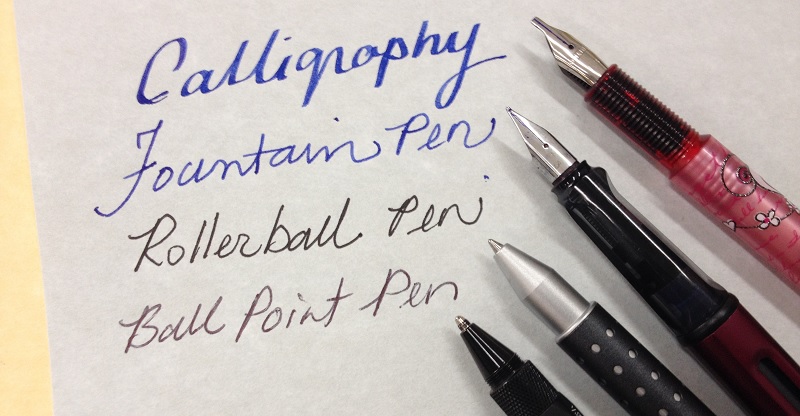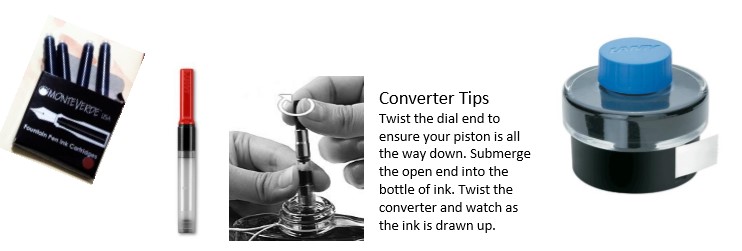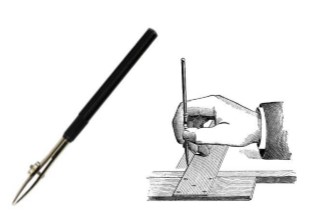A good pen feels good in your hand. It makes you want to write, draw and doodle. The Paint Spot is proud to stock many popular lines of writing pens. The best way to select a pen is to try it and see how you like it. If it feels good and fits your style, go for it! Let’s compare calligraphy and fountain pens, rollerball and ballpoint pens, and describe a few specialty pens. Each pen type has its purpose, benefits, and drawbacks. Here is a quick reference.
Fountain pens vs calligraphy pens
Fountain and calligraphy pens belong to a family of the finest writing implements. They’re common gifts to graduates, and retirees of law, industry, and commerce. In truth, fountain pens are a mark of sophistication. They are also the tools of choice for artists, illustrators, cartoonists, poets, and others.
Fountain and calligraphy pen ink delivery systems
Only the style of nib distinguishes between a fountain pen and a calligraphy pen. The nib, or writing tip, is the point that delivers the ink to the paper. To write, both fountain and calligraphy pens rely on capillary action, rather than friction. Capillary action is the intermolecular attractive force or surface tension that causes water molecules to follow molecule-by-molecule out of fountain and calligraphy nibs. As a result, both styles of pens effortlessly glide over the page and give handwriting a unique character.
Which pen nibs?
There are two main types of pen nibs: pointed and broad. Fountain pens have pointed nibs. The ink is thin and flows quite freely through a pointed nib, and it takes little effort to put ink onto paper. It takes some practice to hold the pen at a suitable and constant angle. The nib determines smoothness and flexibility.
Nibs are made from different materials such as steel, rhodium, and gold. It is craftsmanship that determines the quality and durability of the nib. Nibs come in various sizes: EF (extra-fine), F (fine), M (medium), and B (bold). A medium nib is common for most handwriting. If you write small perhaps a fine nib would be preferable.
Use a flourish in your signature when signing important contracts. A bolder nib may suit your needs. Achieve thick and thin strokes by varying the pressure you put on the nib.
Here of some of our favourite Fountain Pens

Calligraphy Pens
Calligraphy pens are a special class of fountain pen. The broader, flat edge is the older of the two nib types. It creates marks varying in thickness. The most common use of calligraphy pens is art projects and stylized penmanship. Holding the pen at a constant angle you can achieve thick and thin strokes by varying the direction of the stroke. You get different results with small, medium or large nib sizes. Nib sizes are measured in millimeters. For expressive journaling, several sizes of nibs are useful.
Ballpoint vs rollerball
Ballpoints
The common ballpoint generally produces a thinner line and requires more pressure for writing than a rollerball, because you need to roll the ball to dispense the ink. The ballpoint uses a viscous ink that dries instantly on paper without smudging. For this reason, and their affordability, ballpoint pens are popular for school and office work. Ballpoint pens are the choice to write on carbon copies – other pens wouldn’t stand up to the force required. However, because of the ink’s formula, it is thicker and stickier, and the ball is not very responsive. The pen may skip or feel scratchy. Also, the ink can dry up in the reservoir, hence very cheap ballpoint pens can stop working even though they appear full of ink.
Rollerballs
These pens glide smoothly and quickly across the page. The ink feels juicier. Rollerballs use a process that puts a greater amount of liquid ink onto the paper than a ballpoint, generally 3-4 times the amount. This is why your rollerball writes more smoothly and the line is so vivid and alive. Rollerballs are wonderfully responsive. The water-soluble inks are ideal for loose sketching and drawing. Try moving the ink around with a wet brush to create a fully realized pen-and-ink wash. With some paper types, rollerballs may cause issues such as bleed-through, feathering, and smudging. Always test your paper.

Here are our picks for durable, high performing rollerballs pens
The body
Select a pen made of several types of materials, including steel, silver, gold, celluloid, plastic, and wood. The material used to make the pen’s body affects its weight and comfort. Avoid hand strain by selecting a lightweight model. Instead of wood or metal, choose one made of rubber or plastic. As you get used to writing with a fountain pen, you might wish to move on to a heftier model. The width of the barrel of the fountain pen is also important. People with smaller hands typically feel more comfortable with a narrow pen. However, a medium-to-large-width fountain pen may actually reduce hand strain. Come to The Paint Spot, where you can try a few models before choosing one that feels right to the touch.
Cartridges, converters, and ink
All our new pens allow continuous use through refills – they’re not disposable, and refills are generally specific to pen styles and brands. Cartridges are the easiest way to refill a fountain pen. A used cartridge is disposable, but clever artists can refill used cartridges with new ink by using a syringe.
The other option is to use an ink converter. These are refillable cartridges that use a plunger mechanism to draw ink in. Many fountain pens are cartridge/converter fountain pens, which means you can choose either. This capability allows users the option to use a larger range of inks and to switch back to cartridges for travel or when they are short of time. Fountain pen ink comes in elegant bottles and a range of colours. By mixing two or more colours together, an unlimited range of custom colours is possible. Make sure to choose inks that are water soluble and suitable to your pens. Refilling need not be messy. Cartridges and converters make it very easy. Lamy ink bottles dispense their own little tissues for tidying up.

Other traditional pens

Ruling pens
A ruling pen is an instrument for drawing with ink or with other drawing fluids. A ruling pen contains ink in a slot between two flexible, tapered, metal jaws. It enables precise rendering of the thinnest lines. Change the line width by adjusting a tension screw connecting the jaws. The adjustment screw can optionally have a number dial. Originally used for technical drawings in engineering and cartography, together with straight rulers and French curves, it’s still used for specific purposes, such as picture framing or calligraphy.
Stylus pens
A stylus is a needle-like tool used in engraving and incising; a stylus also refers to an ancient writing instrument used to inscribe clay or wax tablets. Its shape is usually a narrow, elongated staff, similar to a ballpoint pen. Many styluses are heavily curved to be held more easily. A computer accessory used to assist in navigating or providing more precision when using touchscreens is also a stylus. Another widely used writing tool is the stylus for blind users in conjunction with the slate for punching out the dots in Braille.

Technical pens
A technical pen is a specialized instrument used by an engineer, architect, or drafter to make lines of constant width for architectural, engineering, or technical drawings. A “rapidograph” pen is a trademarked name for one type of technical pen.
Technical pens use either a refillable ink reservoir (isograph version) or a replaceable ink cartridge. In the 1960s, the pen’s design evolved to feature tubes of ink that were filled with a Pasteur pipette or from the narrow spout on a special bottle of ink. This made ink flow more reliable. Extra maintenance and cleaning is required for these pens as the permanent and waterproof nature of the ink may dry and clog the pen. These pens must be frequently and carefully cleaned to remove all ink from the tubing; otherwise, the ink can set and become unremovable. A full set of pens has the following nib sizes: 0.13, 0.18, 0.25, 0.35, 0.5, 0.7, 1.0, 1.4, and 2.0 mm, which correspond to the line widths.
